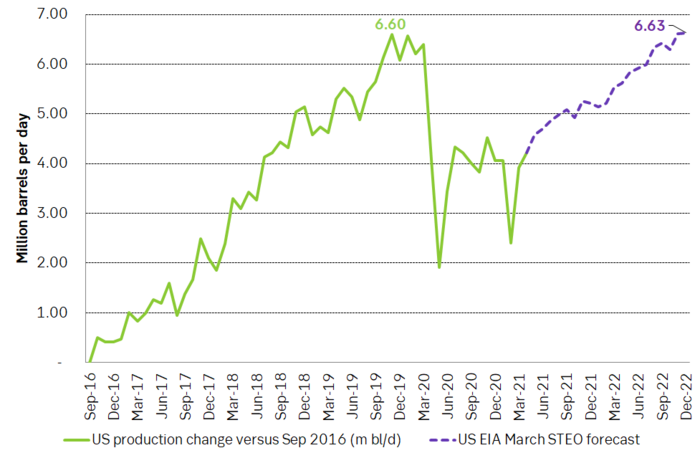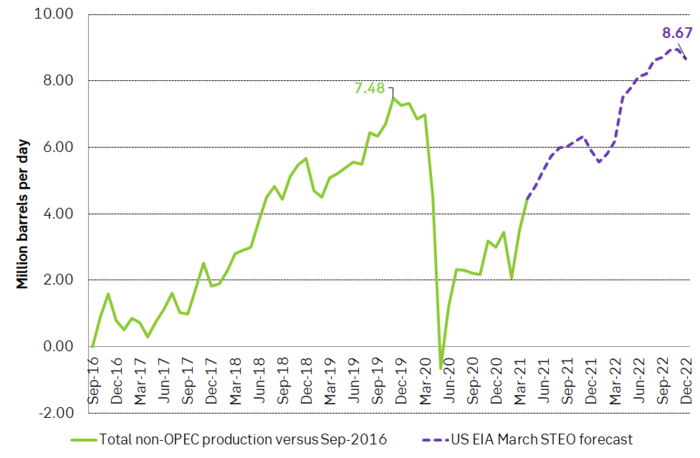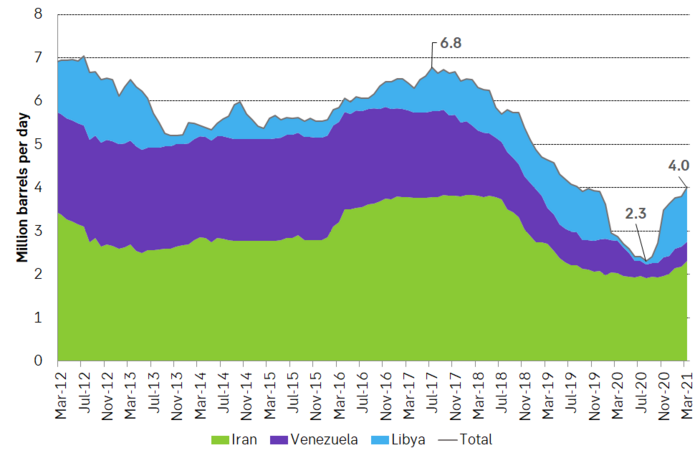Analys
One year after USD -37.63/bl


It is exactly one year since WTI crashed to USD -37.63/bl. Yes, it was probably trading games involved. Yes, it was highly specific to storage and pipeline constraints at the pricing point of WTI in Cushing Oklahoma as Brent crude only fell to USD 19.33/bl. Yes, it was a price war between Russia and Saudi Arabia which broke out after the 6 March meeting. Yes, it was Covid-19 lock-downs which killed demand. But what really stands out looking back was that you don’t steal from the King. You don’t steal from OPEC. You don’t steal market shares from the world’ lowest cost producers. Try that again and you’ll get punished again.

The price war between Russia and Saudi Arabia which broke out after the 6 March meeting last year looked like an ill considered tantrum from a hot tempered Muhammed bin Salman in Saudi Arabia lashing out against Russia which did not want to play the ”hold back production, loose market share, get higher prices” game any more. And maybe such a tantrum was really what happen. Who knows.
But the underlying fundamentals story here was that US liquids production was growing like crazy. From Sep 2016 to Jan 2020 it grew by 6.6 m bl/d. And Russia was sick of holding back production forever while seeing US taking more and more market share. The only reason for why this could go on as long as it did was because there was an almost comparable large decline in supply from the key OPEC producers being Venezuela, Iran and Libya which lost 4.5 m bl/d from mid-2017 to mid-2020. Thus yielding room for the incredible US production growth.
It was like the business strategy of US shale oil players was: ”Let’s steel market share from the lowest cost producers in the world being OPEC/OPEC+. Fundamentally that is a no-go strategy to start. Though it can go on for a little while before it falls apart. And it did go on for a little while but largely because of the very large decline from Venezuela, Libya and Iran. But looking back it is obvious that it had to end.
OPEC knows very well that the oil price is all about controlling supply. There is an infinite amount of oil under ground. Make sure it is not too much above ground and you’ll get rich. I.e. control your capex spending. US shale oil players obviously have been nowhere near thinking along such lines.
Looking forward is not all such a great picture if we base it on 1) The ongoing return of production from Iran and Libya. I.e. the reversal of the losses within OPEC from mid-2017 which enabled the US shale oil boom to go on as long as it did and 2) The projected non-OPEC production growth from the US EIA in its March STEO pointing to a very strong rebound in both US shale oil and total non-OPEC production towards the end of 2022.
The key message from 20 April 2020 is: Do not steal from the King. Do not try to steal market shares from the worlds lowest cost producers (it is stupid). If you do you will get punished again. In a world where oil demand is growing at around 1% over the coming years you should not lay plans for growing your production at 2% or 5% or 10% per year. Because if you do it fundamentally means that you must steel market share from someone. It for sure won’t be the lowest cost producers.
The end-game though could be that there is only one way to tame the production from non-OPEC and that is a lower price.
Brent and WTI crude prices and the crazy WTI crash to USD -37.63/bl. The recovery since then is all due to deep cuts in production by OPEC+ and still is. If OPEC+ hadn’t still been holding back significant volumes then we would have had no more than USD 30-40/bl today.

Crazy US hydrocarbon liquids growth. From a low in Sep-2016 it grew by 6.6 m bl/d before the collapse in Q1-2020. According to the EIA’s STEO from March it is set to revive and reach the same gain at the end of 2022 though the EIA STEO from April has modified that a bit lower again.

The same chart for changes in total non-OPEC production since Sep-2016 gives much the same picture. What we see is that it is not only US production which increased but also other non-OPEC producers lifted increased production in this period. But mostly it is US.

And the maga-growth in non-OPEC production did of course take their market share from OPEC. Massive decline in production by three OPEC members Iran, Venezuela and Iran. Libya has now kicked back with more to come and Iran is just about to move into the market again as signals from the ongoing Vienna talks on the revival of JCPOA (Iran nuclear deal) are positive with all sides at the table wanting the same thing. Saudi Arabia, Israel and the Iranian Revolutionary Guard may not want success but they are not sitting at the negotiation table in Vienna. A strong rebound in non-OPEC production as envisioned by the EIA March STEO forecast will be outright impossible with a production revival from these three countries.

Analys
Tightening fundamentals – bullish inventories from DOE

The latest weekly report from the US DOE showed a substantial drawdown across key petroleum categories, adding more upside potential to the fundamental picture.

Commercial crude inventories (excl. SPR) fell by 5.8 million barrels, bringing total inventories down to 415.1 million barrels. Now sitting 11% below the five-year seasonal norm and placed in the lowest 2015-2022 range (see picture below).
Product inventories also tightened further last week. Gasoline inventories declined by 2.1 million barrels, with reductions seen in both finished gasoline and blending components. Current gasoline levels are about 3% below the five-year average for this time of year.
Among products, the most notable move came in diesel, where inventories dropped by almost 4.1 million barrels, deepening the deficit to around 20% below seasonal norms – continuing to underscore the persistent supply tightness in diesel markets.
The only area of inventory growth was in propane/propylene, which posted a significant 5.1-million-barrel build and now stands 9% above the five-year average.
Total commercial petroleum inventories (crude plus refined products) declined by 4.2 million barrels on the week, reinforcing the overall tightening of US crude and products.


Analys
Bombs to ”ceasefire” in hours – Brent below $70

A classic case of “buy the rumor, sell the news” played out in oil markets, as Brent crude has dropped sharply – down nearly USD 10 per barrel since yesterday evening – following Iran’s retaliatory strike on a U.S. air base in Qatar. The immediate reaction was: “That was it?” The strike followed a carefully calibrated, non-escalatory playbook, avoiding direct threats to energy infrastructure or disruption of shipping through the Strait of Hormuz – thus calming worst-case fears.

After Monday morning’s sharp spike to USD 81.4 per barrel, triggered by the U.S. bombing of Iranian nuclear facilities, oil prices drifted sideways in anticipation of a potential Iranian response. That response came with advance warning and caused limited physical damage. Early this morning, both the U.S. President and Iranian state media announced a ceasefire, effectively placing a lid on the immediate conflict risk – at least for now.
As a result, Brent crude has now fallen by a total of USD 12 from Monday’s peak, currently trading around USD 69 per barrel.
Looking beyond geopolitics, the market will now shift its focus to the upcoming OPEC+ meeting in early July. Saudi Arabia’s decision to increase output earlier this year – despite falling prices – has drawn renewed attention considering recent developments. Some suggest this was a response to U.S. pressure to offset potential Iranian supply losses.
However, consensus is that the move was driven more by internal OPEC+ dynamics. After years of curbing production to support prices, Riyadh had grown frustrated with quota-busting by several members (notably Kazakhstan). With Saudi Arabia cutting up to 2 million barrels per day – roughly 2% of global supply – returns were diminishing, and the risk of losing market share was rising. The production increase is widely seen as an effort to reassert leadership and restore discipline within the group.
That said, the FT recently stated that, the Saudis remain wary of past missteps. In 2018, Riyadh ramped up output at Trump’s request ahead of Iran sanctions, only to see prices collapse when the U.S. granted broad waivers – triggering oversupply. Officials have reportedly made it clear they don’t intend to repeat that mistake.
The recent visit by President Trump to Saudi Arabia, which included agreements on AI, defense, and nuclear cooperation, suggests a broader strategic alignment. This has fueled speculation about a quiet “pump-for-politics” deal behind recent production moves.
Looking ahead, oil prices have now retraced the entire rally sparked by the June 13 Israel–Iran escalation. This retreat provides more political and policy space for both the U.S. and Saudi Arabia. Specifically, it makes it easier for Riyadh to scale back its three recent production hikes of 411,000 barrels each, potentially returning to more moderate increases of 137,000 barrels for August and September.
In short: with no major loss of Iranian supply to the market, OPEC+ – led by Saudi Arabia – no longer needs to compensate for a disruption that hasn’t materialized, especially not to please the U.S. at the cost of its own market strategy. As the Saudis themselves have signaled, they are unlikely to repeat previous mistakes.
Conclusion: With Brent now in the high USD 60s, buying oil looks fundamentally justified. The geopolitical premium has deflated, but tensions between Israel and Iran remain unresolved – and the risk of missteps and renewed escalation still lingers. In fact, even this morning, reports have emerged of renewed missile fire despite the declared “truce.” The path forward may be calmer – but it is far from stable.
Analys
A muted price reaction. Market looks relaxed, but it is still on edge waiting for what Iran will do

Brent crossed the 80-line this morning but quickly fell back assigning limited probability for Iran choosing to close the Strait of Hormuz. Brent traded in a range of USD 70.56 – 79.04/b last week as the market fluctuated between ”Iran wants a deal” and ”US is about to attack Iran”. At the end of the week though, Donald Trump managed to convince markets (and probably also Iran) that he would make a decision within two weeks. I.e. no imminent attack. Previously when when he has talked about ”making a decision within two weeks” he has often ended up doing nothing in the end. The oil market relaxed as a result and the week ended at USD 77.01/b which is just USD 6/b above the year to date average of USD 71/b.

Brent jumped to USD 81.4/b this morning, the highest since mid-January, but then quickly fell back to a current price of USD 78.2/b which is only up 1.5% versus the close on Friday. As such the market is pricing a fairly low probability that Iran will actually close the Strait of Hormuz. Probably because it will hurt Iranian oil exports as well as the global oil market.
It was however all smoke and mirrors. Deception. The US attacked Iran on Saturday. The attack involved 125 warplanes, submarines and surface warships and 14 bunker buster bombs were dropped on Iranian nuclear sites including Fordow, Natanz and Isfahan. In response the Iranian Parliament voted in support of closing the Strait of Hormuz where some 17 mb of crude and products is transported to the global market every day plus significant volumes of LNG. This is however merely an advise to the Supreme leader Ayatollah Ali Khamenei and the Supreme National Security Council which sits with the final and actual decision.
No supply of oil is lost yet. It is about the risk of Iran closing the Strait of Hormuz or not. So far not a single drop of oil supply has been lost to the global market. The price at the moment is all about the assessed risk of loss of supply. Will Iran choose to choke of the Strait of Hormuz or not? That is the big question. It would be painful for US consumers, for Donald Trump’s voter base, for the global economy but also for Iran and its population which relies on oil exports and income from selling oil out of that Strait as well. As such it is not a no-brainer choice for Iran to close the Strait for oil exports. And looking at the il price this morning it is clear that the oil market doesn’t assign a very high probability of it happening. It is however probably well within the capability of Iran to close the Strait off with rockets, mines, air-drones and possibly sea-drones. Just look at how Ukraine has been able to control and damage the Russian Black Sea fleet.
What to do about the highly enriched uranium which has gone missing? While the US and Israel can celebrate their destruction of Iranian nuclear facilities they are also scratching their heads over what to do with the lost Iranian nuclear material. Iran had 408 kg of highly enriched uranium (IAEA). Almost weapons grade. Enough for some 10 nuclear warheads. It seems to have been transported out of Fordow before the attack this weekend.
The market is still on edge. USD 80-something/b seems sensible while we wait. The oil market reaction to this weekend’s events is very muted so far. The market is still on edge awaiting what Iran will do. Because Iran will do something. But what and when? An oil price of 80-something seems like a sensible level until something do happen.
-

 Nyheter3 veckor sedan
Nyheter3 veckor sedanStor uppsida i Lappland Guldprospekterings aktie enligt analys
-

 Nyheter4 veckor sedan
Nyheter4 veckor sedanBrookfield ska bygga ett AI-datacenter på hela 750 MW i Strängnäs
-

 Nyheter4 veckor sedan
Nyheter4 veckor sedanSommaren inleds med sol och varierande elpriser
-

 Nyheter3 veckor sedan
Nyheter3 veckor sedanSilverpriset släpar efter guldets utveckling, har mer uppsida
-

 Analys4 veckor sedan
Analys4 veckor sedanBrent needs to fall to USD 58/b to make cheating unprofitable for Kazakhstan
-

 Nyheter4 veckor sedan
Nyheter4 veckor sedanTradingfirman XTX Markets bygger datacenter i finska Kajana för 1 miljard euro
-

 Nyheter2 veckor sedan
Nyheter2 veckor sedanUppgången i oljepriset planade ut under helgen
-

 Nyheter2 veckor sedan
Nyheter2 veckor sedanLåga elpriser i sommar – men mellersta Sverige får en ökning









